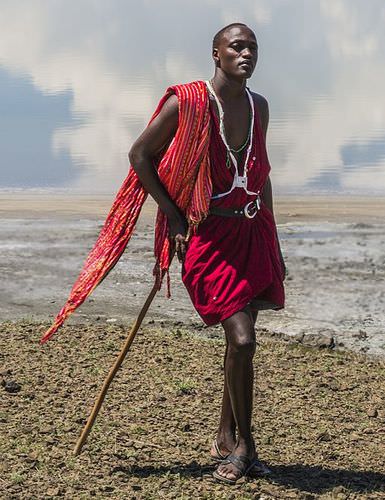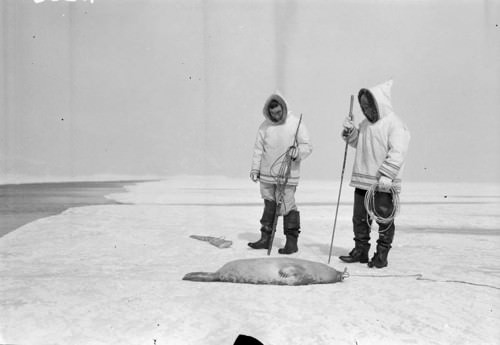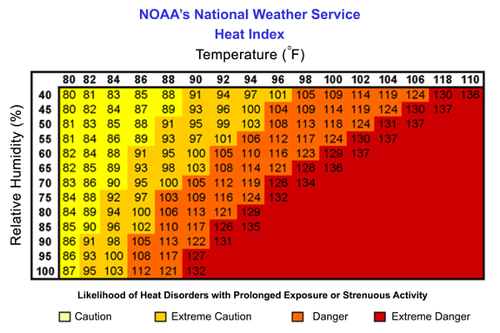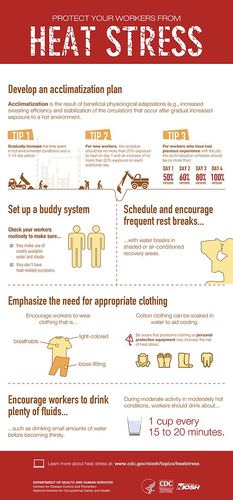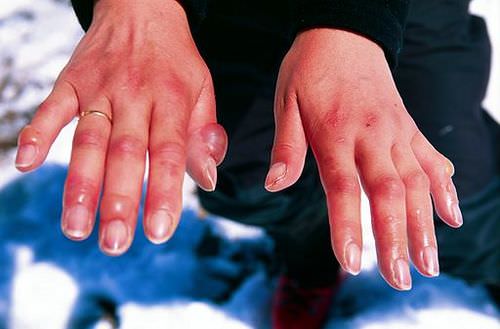8.9 人类应对极端气候的措施
章节大纲
-
Built for Heat
::热热建造This tall, slender man lives near the equator in Kenya, East Africa — one of the hottest regions of the world. He and the other people of his tribal group, called the Maasai, are among the tallest, most linear people on the planet. Their body build is thought to be an adaptation to their climate , which is hot year-round.
::这个高高、苗条的人住在肯尼亚赤道附近,东非是世界最热的地区之一,他和他的部落群体中其他被称为马赛人的人是地球上最高、最线性的人,他们的身体结构被认为适应了他们全年炎热的气候。Climate Extremes
::气候极端Climate refers to the average weather conditions in a region over a long period of time. One of the main determinants of climate is temperature. Both hot and cold temperatures are serious environmental stresses on the .
::气候是指一个区域长期的平均天气状况,气候的主要决定因素之一是温度,热温和冷温都是对气候的严重环境压力。In the cold, there is risk of hypothermia, which is a dangerous decrease in core body temperature. The normal temperature of the human body is 37 degrees C (98.6 degrees F). Hypothermia sets in when body temperature drops to 34.4 degrees C (94 degrees F). If body temperature falls below 29.4 degrees C (85 degrees F), it starts to cool very rapidly because the body’s temperature regulation mechanism starts to fail.
::在寒冷中,有低温的风险,这是核心体温的危险下降。人体的正常温度为37摄氏度(98.6摄氏度)。 当体温降至34.4摄氏度(94摄氏度)时,会发生催眠。 如果体温降到29.4摄氏度(85摄氏度)以下,则会开始非常迅速地冷却,因为体温调节机制开始失效。The opposite problem occurs in the heat, where the risk is hyperthermia, which is a dangerous increase in core body temperature. If human body temperature rises above about 40.6 degrees C (105 degrees F), hyperthermia may become life threatening. If a temperature this high persists more than a few days, it generally damages the brain and other internal organs , leading to death.
::相反的问题发生在热热中,那里的风险是高温,这是核心体温的危险上升。 如果人体温度上升超过40.6摄氏度(105摄氏度),高温可能会危及生命。 如果温度持续超过几天,通常会损害大脑和其他内脏,导致死亡。Human Adaptation to Heat and Cold
::人类适应热和寒热的适应Humans are the most widespread on the planet, and they have lived in extreme climates for tens of thousands of years. As a result , many human have had to cope with extreme temperatures for hundreds of generations, which has forced them to develop genetic adaptations to these climate extremes.
::人类是地球上最普遍的,他们已经生活在极端气候中数万年了。 结果,许多人不得不在数以百代人的时间里应对极端温度,这迫使他们对这些极端气候进行基因改造。The size and proportions of the human body may play an important role in how well an individual is able to handle hot or cold temperatures. In general, people with a tall, slender build, like the Maasai man pictured above, are well adapted to heat, whereas people with a short, stocky build (like the Inuit indigenous North Americans pictured ) are well adapted to cold. These relationships between body build and climate were first noticed in other species in the 1800s by biologists Carl Bergmann and Joel Allen. These scientists formulated what are now known as Bergmann’s and Allen’s rules.
::人类身体的大小和比例在一个人能够应付炎热或寒冷的温度方面可能起到重要作用。 一般来说,高高、苗条建筑的人,如上面的马赛人,非常适合热,而短小的建筑的人(如因努伊特土著北美人所画的)则非常适合冷酷。 生物学家卡尔·伯格曼(Carl Bergmann)和乔尔·艾伦(Joel Allen)在1800年代首次发现身体构造和气候之间的关系在其他物种中。 这些科学家提出了现在被称为Bergmann和Allen(Allen)的规则。These Inuit seal hunters at Pond Inlet, Canada, which has a polar arctic climate, have a body build that is cold adapted.
::这些因努伊特海豹猎人 在加拿大Pond Inlet, 具有极地北极气候, 其身体结构适应寒冷。Bergmann’s Rule
::伯格曼规则Bergmann's rule states that within a broadly distributed taxonomic group, populations or species of larger size are found in colder environments, whereas populations or species of smaller size are found in warmer environments. Bergmann’s rule has been shown to generally apply to widespread species of mammals and , although there are also many exceptions to the rule.
::Bergmann的规则指出,在一个分布广泛的分类组内,较寒冷的环境中发现人口或较大物种,而较暖的环境下则发现人口或较小物种。 事实证明,Bergmann的规则一般适用于广泛的哺乳动物物种,尽管该规则也有许多例外。What explains Bergmann’s rule? Larger animals have a lower surface area to volume ratio than smaller animals, which is illustrated in the table for a simple shape, a cube. From the table, you can see how the surface area to volume ratio of a cube decreases dramatically as the size of the cube increases. Because heat is lost through the surface of the body, an animal with a smaller surface area to volume ratio radiates less body heat per unit of mass. The larger body mass also allows the animal to generate more heat. A larger animal has more , so it can produce more body heat as a byproduct of cellular metabolism . Both of these factors allow a larger animal to stay warmer in a cold climate.
::Bergmann 的规则是什么? 大型动物的表面积与体积比小动物的体积比较低,在表格中以简单的形状 — — 立方体来显示。从表格中,可以看到立方体的大小随着立方体的大小而急剧下降。由于体表面积与体积之比较小,动物的体积与体积之比会降低,动物的体积与体积之比会降低。更大的体积也可以使动物产生更多的热。更大的动物有更大的体积,因此可以产生更多的体温,作为细胞代谢的副产品。这两个因素都允许更大的动物在寒冷的气候中保持更温暖。Relationship of Surface Area to Volume in Cubes of Different Sizes Side of Cube (cm) Surface Area of Cube (cm 2 ) Volume of Cube (cm 3 ) Surface Area:Volume Ratio 2 24 8 3:1 4 96 64 3:2 6 216 216 3:3 12 864 1728 3:6 20 2400 8000 3:10 Warmer climates impose the opposite problem: body heat generated by metabolism needs to be dissipated quickly rather than stored within the body. Smaller animals have a higher surface area to volume ratio that maximizes heat loss through the surface of the body and helps cool the body. With less mass and fewer cells, smaller animals also generate less heat due to cellular metabolism.
::温室气候造成了相反的问题:新陈代谢产生的体热需要迅速消散,而不是储存在体内。 较小型的动物的表面积与体积比较高,通过身体表面最大限度地减少热量,有助于冷却身体。 体积较小,细胞较少,细胞新陈代谢导致的体热也较少。Anthropologists have found that many human populations tend to follow Bergmann’s rule. For example, a study of 100 human populations in the 1950s found a strong negative correlation between mean body mass and average yearly temperature. In other words, higher body mass was generally found in colder places, and lower body mass was generally found in hotter places.
::人类学家发现,许多人类人口倾向于遵循伯格曼的统治。 比如,1950年代对100人进行的一项研究发现,平均身体质量和平均年温之间存在强烈的负相关关系。 换句话说,高身体质量一般在更冷的地方发现,低身体质量一般在更热的地方发现。There are also exceptions to the rule, in part because we use cultural responses to temper environmental stresses so we do not need to change genetically or physiologically in order to cope. H umans, for example, use clothing and heated buildings to stay warm in cold climates, which tends to counter the effects of changing human body shape in cold climates.
::这一规则也有例外,部分原因是我们利用文化应对环境压力的温和反应,这样我们不必为了应付而改变基因或生理。 比如,人类在寒冷的气候中用衣服和加热的建筑来保持温暖,这往往抵消了寒冷气候中人体形状变化的影响。Allen’s Rule
::艾伦规则Allen’s rule is a corollary of Bergmann’s rule. It states that animals living in hotter climates generally have longer extremities (such as limbs, tails, snouts, and ears) than closely related animals living in colder climates. The explanation for Allen’s rule is similar to the rationale behind Bergmann’s rule. Longer extremities maximize an animal’s surface area, allowing greater heat loss through the surface of the body. Therefore, having long extremities is adaptive in hot climates where the main challenge is dissipating body heat.
::艾伦规则是贝尔格曼规则的必然结果。 它指出,生活在热热气候中的动物通常比生活在冷热气候中的密切相关动物有更长的距离(如四肢、尾巴、鼻涕和耳朵 ) 。 艾伦规则的解释与贝尔格曼规则背后的理由相似。 更远的距离使动物的表面面积最大化,允许在身体表面出现更大的热量流失。 因此,长期的距离是适应热气候的适应性,而热气候的主要挑战是消散体温。Anthropologists have noted that, in populations that have lived in regions for long periods of time, the limbs of people tend to be longer in proportion to overall body height. The Maasai man pictured above is a clear example of this. His exceptionally long limbs — like those of other members of his population — are optimally proportioned for his hot climate. The shorter-limbed body proportions of the Inuit men (also pictured above) suit them well for their cold climate. Marked differences in limb length have also been observed in related populations that have lived for long periods of time at different altitudes. High altitudes have colder climates than lower altitudes and — consistent with Allen's rule —people tend to have shorter limbs at higher altitudes.
::人类学家指出,在长期居住在这些地区的人口中,人们的四肢与整体身高的比例往往要长一些,上面所描绘的马赛人就是这方面的一个明显例子,他特别长的四肢与其人口中的其他成员一样,最适合其炎热的气候,因努伊特人身体比例较短(如上图所示),适合其寒冷的气候。在长期在不同高度生活的相关人群中,也观察到四肢长度的明显差异。高海拔的气候比低海拔低,而且根据艾伦的规则,高海拔的人群往往有较短的四肢。Other Human Responses to Heat
::人类对热量的其他反应Humans exhibit several other responses to high temperatures that are generally considered either short-term physiological responses or examples of longer-term acclimatization.
::人类展示了对高温的其他几种反应,一般认为这些反应是短期生理反应或长期适应化的例子。Sweating and Humidity
::湿湿和湿度Because humans are basically tropical animals, we generally have an easier time dealing with excessive heat than excessive cold. Evaporation of sweat is the main way we cool the body. The aerobics instructor in the photo is sweating copiously while working out in a hot environment. Why does sweating cool us? When sweat evaporates from the skin, it requires heat. The heat comes from the surface of the body, resulting in evaporative cooling.
::由于人类基本上是热带动物,我们通常比过度寒冷更容易处理过热问题。 汗水蒸发是我们冷却身体的主要方式。 照片中的有氧教练在热环境中工作时汗水充沛。 为什么汗水会冷却我们? 当汗水从皮肤中蒸发时,它需要热。 热能来自身体表面,导致蒸发冷却。Sweating is a normal response to heat stress.
::润滑是正常反应 热应激。How well we can deal with high air temperatures depends in large part on the humidity of the air. We have a harder time losing excess body heat when the humidity is high because our sweat does not evaporate as well as it does when the humidity is low. Instead, the sweat stays on the skin, making us feel clammy and warmer than we would feel if the humidity were lower. If the air is dry, on the other hand, sweat evaporates readily, and we feel more comfortable. For this reason, we are able to tolerate higher temperatures when the humidity is low. This is the basis of the common aphorism, “It’s not the heat, but the humidity.”
::面对高空温度,我们如何能应对高空温度在很大程度上取决于空气的湿度。 当湿度高时,我们更难失去超热的体温,因为我们的汗水不会蒸发,而湿度低时会蒸发。 相反,汗水停留在皮肤上,令我们感到热和温暖,比湿度低时更感知。 另一方面,如果空气干燥,汗水就会蒸发,我们感到更舒适。 因此,当湿度低时,我们可以忍受更高的温度。 这是常识主义的基础 , “ 它不是热,而是湿度。 ”The heat index (HI) is a number that combines air temperature and relative humidity to indicate how hot the air feels due to the humidity. The heat index is also called "apparent temperature.” The table below shows the heat index at different combinations of air temperature and relative humidity. As you can see, when the humidity is very high, even a 90 degree F temperature can be very dangerous.
::热指数(HI)是结合空气温度和相对湿度的数字,以表明空气因湿度而感到的热度。热指数也称为“明显温度 ” 。 下表显示了不同天气温度和相对湿度组合的热指数。 正如你可以看到的那样,当湿度非常高时,甚至90度F的温度都非常危险。Acclimatization to Heat
::升温至热If humidity is low, evaporation of sweat can be an effective way to keep the body from overheating. However, the loss of and salts in sweat can also be dangerous. In very hot conditions, an adult may lose up to four liters of sweat per hour and up to 14 liters per day. Such water losses may cause severe dehydration if the water is not replaced by drinking much more than usual. The loss of salts may also upset the normal salt balance in the body, which can be dangerous. Becoming acclimatized to heat by gradually increasing the exposure time to high temperatures — particularly while exercising or doing physical work — can reduce the risk of these effects.
::如果湿度低,汗水蒸发可以成为防止身体过热的有效办法,但汗水和盐类的流失也可能是危险的,在非常热的环境下,成年人每小时可能损失多达4升汗水,每天可能损失多达14升汗水,如果水不比通常多得多地饮用,这种缺水可能导致严重脱水,盐水的流失还可能破坏身体正常的盐平衡,这种平衡可能很危险,通过逐步增加高温的暴露时间(特别是在锻炼或做体力活时)来适应热能,可以减少这些影响的风险。It may take up to 14 days to attain maximum heat acclimatization. As the body becomes acclimatized, sweat output increases, and sweating begins sooner. The salt content of the sweat also declines, as does the output of urine . These and other physiological changes help the body lose heat through the evaporation of sweat, while maintaining the proper balance of salts and fluids in the body. There may also be increased flow to the body surface through the widening of near the skin. This is called vasodilation. This brings more heat from the body core to the skin, and from there it may be radiated out into the environment. The poster below provides guidelines for outdoor workers on how to become acclimatized to heat and other tips for dealing safely with this stress.
::达到最大热度化可能需要14天时间。 当身体变得适应化, 汗水输出增加, 汗水开始更快地开始出汗。 汗水中的盐含量也下降, 尿液的产量也下降。 这些和其他生理变化帮助身体通过汗水蒸发而失去热量, 同时保持体内盐类和液体的适当平衡。 通过皮肤附近扩大, 也可能增加进入身体表面的流量。 这被称为血管化。 这会增加身体核心的热量, 并由此将热量从皮肤中释放出来。 下面的海报为室外工人提供了如何适应热的指南, 以及安全处理这种压力的其他提示 。Becoming acclimatized to heat allows one to safely perform more or work in the heat. It also helps prevent heat-related illnesses by reducing strain on the body. Heat-related illnesses — from least to most serious — include heat cramps, heat exhaustion, and heat stroke .
::热的适应使一个人能够安全地进行更多的工作或在热中工作,还有助于通过减轻对身体的压力来预防与热有关的疾病,与热有关的疾病——从最少到最严重的疾病——包括热抽搐、热耗竭和中热。-
Heat cramps are muscle spasms caused by loss of water and salts. They often follow prolonged sweating brought on by over-exertion in hot weather.
::热抽筋是水和盐类流失造成的肌肉抽筋,经常是天气过热引起的长期出汗。 -
Heat exhaustion is a condition in which over-heating of the body causes dizziness, headache, profuse sweating, rapid heartbeat. and other symptoms. Without prompt treatment, heat exhaustion can lead to heat stroke.
::热耗竭是身体过热导致头晕、头痛、大出汗、心跳迅速和其他症状的一种情况。 不及时治疗,热耗竭会导致发热。 -
Heat stroke is potentially life threatening and a medical emergency. Heat stroke results from prolonged exposure to high temperatures, usually in combination with dehydration. It leads to failure of the body's temperature control system and is diagnosed when the core body temperature exceeds 105 degrees F. Symptoms may include nausea, seizures, confusion, disorientation, and coma.
::热中风有潜在生命威胁和医疗紧急情况,长期暴露于高温,通常与脱水相结合,导致体温控制系统失灵,当核心体温超过105摄氏度时诊断出。 症状可能包括恶心、癫痫、混乱、迷惑和昏迷。
Acclimatization to heat, like other types of acclimatization, is a reversible process. Just as quickly as heat acclimatization occurs, the physiological changes fade away in the absence of heat exposure. The body returns to its baseline state within a week or two of no longer exercising or working at high temperatures.
::升温与其他类型的升温一样,是一种可逆的过程。 与热的升温一样,热的升温过程也是一种可逆的过程。 正如热升温发生的速度一样,在没有热暴露的情况下,生理变化会消失。 身体在一周或两周内恢复到其基准状态,在高温下不再锻炼或工作。Other Human Responses to Cold
::人类应对寒冷的其他对策Besides genetic difference in body build, there are two major ways the human body can respond to the cold. One way is by producing more body heat, and the other way is by conserving more body heat. An immediate response to cooling of the body is shivering . This is an involuntary and simultaneous contraction of many tiny in the body. These muscle contractions generate a small amount of heat. Another early response to cold temperature is a narrowing of blood vessels near the skin. This is called vasoconstriction. This helps to shunt blood away from the body surface so more heat is held at the body core. The skin cools down and radiates less heat into the environment.
::除了身体结构的遗传差异外,人体还可以用两种主要方法应对寒冷。一种是产生更多的体热,另一种是保存更多的体热。对身体冷却的即时反应是发抖。这是身体许多小的非自愿同时收缩。肌肉收缩产生少量的热量。另一种对寒冷温度的早期反应是血管血管靠近皮肤的缩小。这被称为血管收缩。这有助于将血液从身体表面抽取,这样将更多的热控制在身体核心。皮肤向下冷却,将较少的热量照射到环境中。Hunting Response
::狩猎对策At temperatures below freezing, vasoconstriction can be dangerous if it lasts too long. The extremities become too cold because of lack of blood flow, and cold injury (such as frostbite) may occur. Frostbite is tissue destruction that occurs when tissue freezes. You can see a mild-to-moderate case of frostbite of the fingers in the photo . If frostbite is severe, it may lead to gangrene and amputation of the affect extremities.
::在冰冻以下的温度下,血管收缩如果持续时间太长,就可能很危险。由于血液缺乏流动,极端情况变得太冷,而且可能发生冷伤(如冻土)。霜冻是组织冻结时发生的组织破坏。你可以看到照片中的手指有轻微到中度的冻土。如果冻土很严重,可能导致坏疽和断肢。Even moderate frostbite may produce blistering of the affected skin.
::即使是中度的冻土也可能造成受污染皮肤的肿胀。The body counters the possibility of cold injury with a reaction called the hunting response. This is a process of alternating vasoconstriction and vasodilation in extremities exposed to cold. About five to ten minutes after the start of cold exposure, the blood vessels in the extremities suddenly dilate, which increases blood flow and subsequently the temperature of the extremities. This is soon followed by another phase of vasoconstriction, and then the process repeats.
::身体与寒伤的可能性相对应,反应称为狩猎反应,这是在暴露于寒冷的体外交替进行血管收缩和血管血管扩张的过程,在开始冷暴露后大约5至10分钟,极端的血管突然膨胀,这增加了血液流动,随后又增加了体外的温度,紧接着是另一阶段血管收缩,然后又重复。The hunting response occurs in most people, but several factors may influence the strength of the response. People who live or work regularly in cold environments show an increased hunting response. T hrough acclimatization, however, tropical residents can develop an increased response, which is indistinguishable from that of residents. Genetic factors may play a role in the hunting response, but this is uncertain because it is difficult to differentiate between adaptation and acclimatization.
::多数人都有狩猎反应,但有几个因素可能影响反应的力度。在寒冷环境中生活或工作的人表现出更多的狩猎反应。然而,通过适应化,热带居民可以增加反应,这与居民的反应是无法区分的。遗传因素在狩猎反应中可能起到作用,但这一点并不确定,因为很难区分适应和适应化。Persistent Vasoconstriction
::持久性血管收缩Where temperatures rarely fall below freezing but are repeatedly very chilly, the hunting response may not occur. Instead, vasoconstriction may persist to keep heat within the body at the expense of cooling the skin. As long as the temperature stays above freezing, cold injury (such as frostbite) will not occur. This type of response has been shown to occur in indigenous dwellers in southern Africa and Australia, where the temperature is hot during the day and very cold at night. People in these populations also tend to deposit fat around the organs in their chest and abdomen. The fat serves as insulation, protecting vital structures from the cold.
::如果温度很少低于冰冻水平,但经常非常寒冷,那么狩猎反应可能就不会发生;相反,血管收缩可能坚持保持体内的热量,以牺牲皮肤的冷却为代价;只要温度维持在冰冻水平以上,就不会发生冷伤(如霜冻),这种反应在南部非洲和澳大利亚的土著居民中发生,那里的白天温度很热,晚上非常寒冷;这些居民还倾向于在胸前和腹部的器官周围放置脂肪;脂肪起到绝缘作用,保护关键结构不受寒冷影响。High-Fat Diet
::高肥饮食Besides shivering, another way to increase body heat is to raise the basal metabolic rate. The basal metabolic rate (BMR) is the amount of energy that a person needs to keep the body functioning at rest. The higher the BMR, the more heat the body generates, even without exercise or physical labor . The BMR can be increased by consuming large quantities of high- calorie fatty foods. People living in very cold subarctic regions, including the Inuit, traditionally ate whale and seal blubber and other high-fat foods, which helped them maintain a high BMR and stay warm.
::除了发抖之外,增加体热的另一个方法是提高巴萨尔代谢率。巴萨尔代谢率(BMR)是指一个人需要多少能量来保持身体的休息。BMR越高,身体产生的热度越高,即使没有锻炼或体力劳动。BMR可以通过消费大量高热量脂肪食品来增加。生活在非常寒冷的亚北极地区的人,包括因努伊特人、传统用餐鲸鱼和海豹鲸脂和其他高脂肪食品,这有助于他们保持高热量的BMR并保持温暖。Feature: Human Biology in the News
::特著:《新闻》中的人类生物学Too many news stories report young children being seriously injured or dying from heat stroke in hot vehicles. On average, 38 children die in hot vehicles each year from heat-related deaths after being trapped inside. Most often, this happens by accident, when a parent or caregiver unknowingly leaves a sleeping child in a car. In other cases, children get into cars on their own, and then cannot get out again.
::太多的新闻报道报道了儿童在热车中严重受伤或死于中暑,平均每年有38名儿童在被困在车内后死于热相关死亡,这种情况往往是意外发生的,因为父母或照料者不知情地将睡眠中的孩子留在车里。 在其他情况下,儿童自己上汽车,然后又无法再出车。A child’s thermoregulatory system is not as efficient as that of an adult, and a child’s body temperature may increase as much as five times faster. This makes children prime candidates for heat stroke. A motor vehicle is also easily heated by direct sun. The windows of the vehicle allow solar radiation to pass through and heat up objects inside. A dark-colored dashboard or seat may quickly reach a temperature of more than 180 degrees F. These hot surfaces can just as quickly heat the adjacent air, rapidly increasing the temperature of the air trapped inside the vehicle.
::儿童的温度调控系统不如成年人那么有效,儿童身体温度的升高可能要快五倍。 这使得儿童成为中热的最佳选择者。 机动车也很容易被直接太阳加热。 车窗允许太阳辐射穿透并给车内物体加热。 深色仪表板或座椅可能很快达到180华氏度以上。 这些热表面可以同样迅速地给邻近空气加热,快速提高车内空气的温度。Here are several simple tips that parents and caregivers can follow to prevent heat stroke tragedies:
::以下是家长及照顾者可以跟进的防止中暑悲剧的简单提示:-
Never leave children alone in or around cars — not even for a minute.
::绝不让儿童独自在汽车内或汽车周围——哪怕一分钟也不例外。 -
Always open the back door and check the back seat before leaving your vehicle to be sure no child has been left behind.
::总是打开后门,检查后座,然后离开你的车,以确保没有儿童被留在后面。 -
Put something you will need, such as your cell phone or handbag, in the back seat so you will have to open the back door to retrieve it whenever you park the car.
::把你的手机或手提包等你需要的东西放在后座上,这样你只要停车,就得打开后门取回它。 -
Keep a large stuffed animal in the child's car seat, and when the child is placed in the car seat, put the stuffed animal in the front passenger seat as a visual reminder that the child is in the back.
::在孩子的汽车座椅上保留一个大的填充动物,当孩子被放在汽车座椅上时,将填充动物放在前座乘客座椅上,作为视觉提醒,孩子在车尾。 -
Make sure you have a strict policy in place with everyone involved in the care of your child that you should always be called whenever your child does not show up at daycare or school as scheduled.
::确保与所有参与照顾孩子的人制定严格的政策,确保一旦孩子不按期在日托或学校出现,应随时打电话给你。 -
Keep vehicles locked at all times, even in driveways and garages. Ask home visitors, child care providers, and neighbors to do the same.
::让家庭访客、儿童保育提供者和邻居也这样做。 -
Keep car keys and remote vehicle openers out of reach of children.
::使车钥匙和边远的车开口器离儿童不远。 -
If a child is missing, immediately check the inside passenger compartments and trunks of all vehicles in the area. Check vehicles even if they are locked, because a child may lock a vehicle after entering and not be able to unlock it again to get out.
::如果儿童失踪,应立即检查该地区所有车辆的客车厢和后备箱,检查车辆,即使车辆是锁着的,因为儿童在进入后可能锁上车辆,无法再次打开车辆出来。 -
If you see a child alone in a vehicle, call 911 immediately. If the child seems hot or sick, get them out of the vehicle as quickly as possible.
::如果你看到一个孩子独自坐在车里,请立即拨打911。如果孩子看上去很热或生病,请尽快把他们带出车外。 -
Pay for gas at the pump and use drive-throughs at the bank, pharmacy, or wherever else they are available.
::银行、药店或其他任何有煤气的地方支付加油泵的煤气费,并使用硬通票。
Summary
::摘要-
Both hot and cold temperatures are serious environmental stresses on the human body. In the cold, there is risk of hypothermia, which is a dangerous decrease in core body temperature. In the heat, there is risk of hyperthermia, which is a dangerous increase in core body temperature.
::热温和冷温都是人体的严重环境压力。 在寒冷中,有低温的风险,这是核心体温的危险下降。 在热热中,有高温的风险,这是核心体温的危险上升。 -
According to Bergmann’s rule, body size tends to be negatively correlated with temperature, because larger body size increases heat production and decreases heat loss. The opposite holds true for small body size. Bergmann’s rule applies to many human populations that are hot or cold adapted.
::根据Bergmann的规则,身体体积往往与温度呈负相关关系,因为体积大会增加热量,减少热量损失。 体积小的情况正好相反。 Bergmann的规则适用于许多适应热度或冷度的人口。 -
According to Allen’s rule, the length of body extremities is positively correlated with temperature, because longer extremities are better at dissipating excess body heat. The opposite applies to shorter extremities. Allen’s rule applies to relative limb lengths in many human populations that have adapted to heat or cold.
::根据艾伦的规则,体外体外长度与温度呈正比关系,因为更长的体外长度比较适合消散超热。 相反,更短的体外长度也适用于较短的体外。 艾伦的规则适用于许多适应热或冷的人群的相对肢体长度。 -
Sweating is the primary way that humans lose body heat. The evaporation of sweat from the skin cools the body. This only works well when the relative humidity is fairly low. At high relative humidity, sweat does not readily evaporate to cool us down. The heat index (HI) indicates how hot it feels due to the humidity.
::汗水是人类失去体温的主要方式。 皮肤的汗水蒸发会冷却身体。 只有在相对湿度相当低的情况下, 汗水才会有效。 在相对高湿度时, 汗水不会轻易蒸发来冷却我们。 热指数(HI)表明湿度导致的热感。 -
Gradually working longer and harder in the heat can bring about heat acclimatization, in which the body has improved responses to heat stress. For example, sweating starts earlier, sweat contains less salt, and vasodilation brings heat to the surface to help cool the body. Full acclimatization takes up to 14 days and reverses just as quickly when the heat stress is removed.
::逐渐地在热中更长时间、更辛苦地工作,可以带来热加速化,让身体对热应激反应得到改善。 比如,早些开始出汗,汗少含盐,血管通热会让表面变热,帮助体温。 完全加速化需要14天时间,在消除热应激时,反转速度同样快。 -
The human body can respond to cold by producing more heat (by shivering or increasing the basal metabolic rate) or by conserving heat (by vasoconstriction at the body surface or a layer of fat-insulating internal organs).
::人体可以通过产生更多热量(通过发抖或增加巴萨尔代谢速率)或通过保护热量(通过身体表面的血管收缩或一层脂肪隔热内器官)对寒冷作出反应。 -
At temperatures below freezing, the hunting response occurs to prevent cold injury, such as frostbite. This is a process of alternating vasoconstriction and vasodilation in extremities that are exposed to dangerous cold. Where temperatures are repeatedly cold but rarely below freezing, the hunting response may not occur, and the skin may remain cold due to vasoconstriction alone.
::在冰冻以下的温度下,狩猎反应会发生,以防止冷伤,如冻冻,这是交替进行血管收缩和血管血管膨胀的过程,在面临危险寒冷的极端地区,这种过程会交替进行。 在温度反复寒冷但很少低于冰冷的地方,狩猎反应可能不会发生,而皮肤可能仅仅由于血管收缩而保持冷却。
Review
::回顾1. Compare and contrast hypothermia and hyperthermia.
::1. 比较和对比低温和高温。2. State Bergmann’s and Allen’s rules.
::2. 贝尔格曼州和艾伦州的规则。3. How do the Maasai and Inuit match the predictions based on Bergmann’s and Allen’s rules?
::3. Maasai人和因努伊特人如何与根据Bergmann和Allen规则作出的预测相匹配?4. Explain how sweating cools the body.
::4. 解释汗水如何冷却身体。5. What is the heat index?
::5. 热指数是什么?6. Relate the heat index to evaporative cooling of the body.
::6. 将热指数与身体蒸发冷却相对应。7. Identify three heat-related illnesses, from least to most serious.
::7. 查明三种与热有关的疾病,从最少到最严重的疾病。8. How does heat acclimatization occur?
::8. 如何实现热通化?9. State two major ways the human body can respond to the cold, and give an example of each.
::9. 说明人体对寒冷作出反应的两个主要方式,并举例说明每一种方式。10. Explain how and why the hunting response occurs.
::10. 解释狩猎反应如何和为何发生。11. Define basal metabolic rate.
::11. 界定巴萨尔代谢率。12. How does a high-fat diet help prevent hypothermia?
::12. 高脂肪饮食如何有助于防止体温过低?13. Explain why frostbite most commonly occurs in the extremities, such as the fingers and toes.
::13. 解释为什么冻土最常发生在极端地区,如手指和脚趾。14. Choose all that apply. Vasodilation...
::14. 选择所有适用的。a. moves blood away from the body’s surface
::a. 将血液从身体表面移走b. moves blood toward the body’s surface
::b. 将血液流向身体表面c. cools the body
::c. 冷却身体d. heats the body
::d. 给身体加热e. is part of the hunting response
::e. 是狩猎反应的一部分15. True or False: Sweating can cause dangerous loss of salts.
::15. 真实的或假的:涂湿可造成危险的盐类流失。16. True or False: In general, increased surface area keeps the body warmer.
::16. 真实或假:一般而言,增加的表面面积使身体变暖。Explore More
::探索更多Wim Hof, nicknamed the “Ice Man,” has trained his nearly naked body to endure bitter cold without suffering ill effects. He has pushed his physiology to extremes that show the human body may be capable of far more than most people assume. Hof has been studied by human biologists who have investigated how he has been able to change his physiology in the face of repeated severe cold stress. Watch these two videos to learn more about this fascinating man and his method of acclimatizing to the cold:
::以“冰人”为绰号的Wim Hof(冰人 ) , 他曾训练他几乎裸体的身体忍受寒冷而不遭受恶劣影响。 他将生理学推向极端,表明人体可能比大多数人想象的要强得多。 人类生物学家已经研究过Hof,研究过他如何在反复严重的寒冷压力下改变生理学。 看这两部录像,以更多地了解这个迷人的人及其适应寒冷的方法: -
Heat cramps are muscle spasms caused by loss of water and salts. They often follow prolonged sweating brought on by over-exertion in hot weather.
